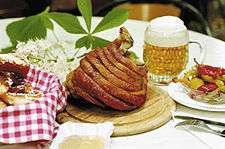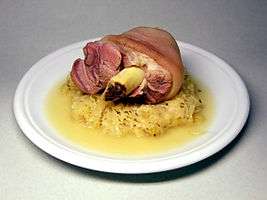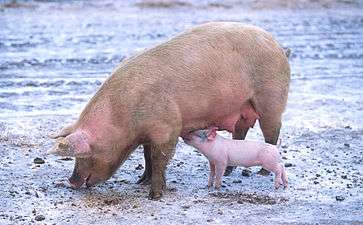Ham hock

A ham hock (or hough) or pork knuckle is the joint between the tibia/fibula and the metatarsals of the foot, where the foot was attached to the hog's leg.[1] It is the portion of the leg that is neither part of the ham proper nor the foot or ankle, but rather the extreme shank end of the leg bone.
Uses
Since this piece generally consists of much skin, tendons and ligaments, it requires long cooking through stewing or braising to be made palatable. The cut of meat can be cooked with greens and other vegetables or in flavourful sauces. It is often added to soups, such as pea and ham soup, with the meat being added to the soup prior to serving. The meat of particularly meaty hocks may be removed and served as is. Ham hocks, like hog jowls (pigs' cheeks), add a distinctive flavor to various dishes. This is particularly true for collard greens, mustard greens, cabbage, green beans and navy beans.
Ham hocks are essential ingredients for the distinct flavor in soul food and other forms of American Southern country cooking. In the Mid-Atlantic States, in rural regions settled by the Pennsylvania Dutch, hocks are a commonly used ingredient for making a kind of meat loaf called scrapple. Eisbein is the name of the joint in north German, and at the same time the name of a dish of roasted ham hock, called Schweinshaxe in Bavaria, Stelze in Austria and Wädli in Switzerland. Golonka is a very popular Polish barbecued dish using this cut. Ham hocks are also popular when boiled with escarole, more commonly called endives, in Italian-American cuisine. Fläsklägg med rotmos is a Swedish dish consisting of cured ham hocks and a mash of rutabaga and potatoes, served with sweet mustard.
Gallery

- Schweinshaxe served with roasted potatoes (Bratkartoffeln) and Sauerkraut at a Bavarian restaurant in Chiang Mai, Thailand
 Roasted Austrian style Stelze
Roasted Austrian style Stelze Pickled Eisbein, with Sauerkraut
Pickled Eisbein, with Sauerkraut
See also
References
- ↑ Wang, Chichi (8 May 2012). "The Nasty Bits: Ham Hock". Serious Eats. Retrieved 8 February 2014.
External links
 Media related to Pork knuckle at Wikimedia Commons
Media related to Pork knuckle at Wikimedia Commons The dictionary definition of ham hock at Wiktionary
The dictionary definition of ham hock at Wiktionary
